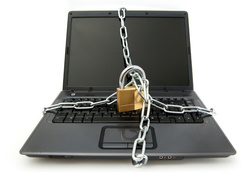Security Basics: Full-Disk Encryption
This post is one in a series of blog posts on the fundamentals of an information security program. You can see the complete list of posts in this series here.
U.S. Healthworks, a California-based healthcare provider, reported a breach recently where a company laptop was stolen from an employee's car. The laptop drive was not encrypted, and it is believed that the personal information of a significant number of customers/patients was stored on this machine.
This is an old, old story, heard many times over.
The need to encrypt laptop hard drives first became widely publicized due to an incident in June of 2006. An employee from the Department of Veteran's Affairs had a department laptop containing personal information on large numbers of veterans (as many as 26 million) at his home, and the laptop was stolen in a burglary.
The most widely-recommended measure for reducing risk of data loss due to a lost or stolen computer is full-disk encryption. Once the drive is encrypted This technology is fairly mature and not terribly complex to implement, but there are some key things to consider when adopting such a system:
http://www.forbes.com/sites/davelewis/2015/06/01/us-healthworks-suffers-data-breach-via-unencrypted-laptop/
http://gcn.com/articles/2012/11/16/after-theft-nasa-orders-laptops-encrypted.aspx
http://searchsecurity.techtarget.com/magazineContent/Use-full-disk-or-file-folder-encryption-for-laptop-data-security
http://www.esecurityplanet.com/network-security/unencrypted-laptop-thefts-expose-personal-medical-financial-data.html
http://www.pymnts.com/news/2015/unencrypted-laptop-exposes-us-healthworks-to-data-breach/#.VcqHY5NViko
http://www.scmagazine.com/contractor-laptops-stolen-data-on-thousands-of-north-shore-lij-patients-at-risk/article/420755/
This is an old, old story, heard many times over.
The need to encrypt laptop hard drives first became widely publicized due to an incident in June of 2006. An employee from the Department of Veteran's Affairs had a department laptop containing personal information on large numbers of veterans (as many as 26 million) at his home, and the laptop was stolen in a burglary.
The most widely-recommended measure for reducing risk of data loss due to a lost or stolen computer is full-disk encryption. Once the drive is encrypted This technology is fairly mature and not terribly complex to implement, but there are some key things to consider when adopting such a system:
- What encryption algorithm is used, and how is it implemented? One good way to ensure a quality implementation is to choose a product that is certified as compliant with the FIPS 140-2 standard.
- How does centralized key recovery work? You want your IT staff to be able to recover a decryption key for any given laptop when necessary, and ideally to be able to remotely provide a recovery services for a staff member who has had to have their login password changed.
- Do you want a product that can work on multiple computing platforms? (Windows, Mac, etc)
- Does the encryption product protect data when the system is in "sleep" mode? In sleep mode (as opposed to hibernate mode), the system is still booted and data is live in RAM, including the disk decryption key. Some products address this potential vulnerability in different ways, while some don't really address it at all.
- Does the system allow for remote wiping of data in addition to encryption? This is a useful additional option.
http://gcn.com/articles/2012/11/16/after-theft-nasa-orders-laptops-encrypted.aspx
http://searchsecurity.techtarget.com/magazineContent/Use-full-disk-or-file-folder-encryption-for-laptop-data-security
http://www.esecurityplanet.com/network-security/unencrypted-laptop-thefts-expose-personal-medical-financial-data.html
http://www.pymnts.com/news/2015/unencrypted-laptop-exposes-us-healthworks-to-data-breach/#.VcqHY5NViko
http://www.scmagazine.com/contractor-laptops-stolen-data-on-thousands-of-north-shore-lij-patients-at-risk/article/420755/




Comments
Post a Comment